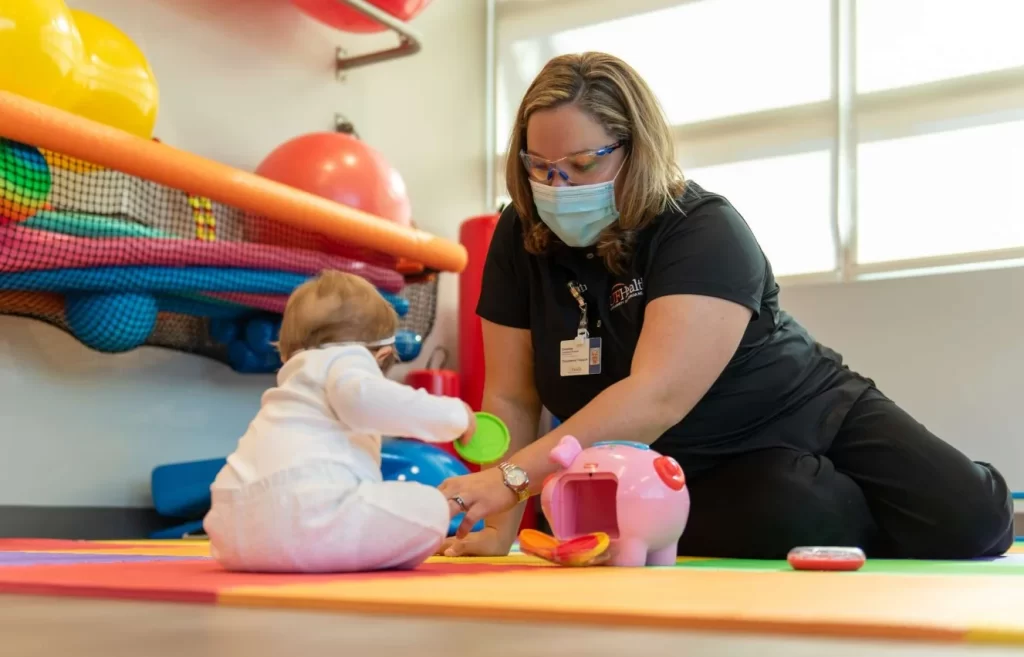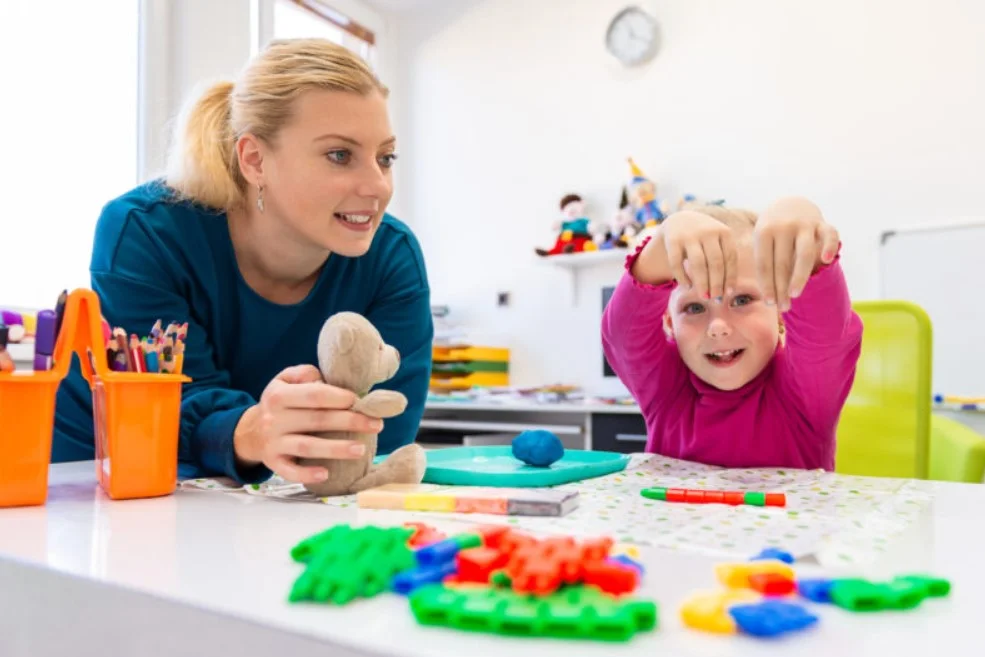How Pediatric Occupational Therapy Can Help Special Children
Every child deserves the opportunity to reach their full potential. But for children with special needs, this can sometimes be challenging. In the intricate journey of childhood development, there are moments when some children require a helping hand to navigate the challenges they face. This is where Pediatric Occupational Therapy, comes into play.
Pediatric occupational therapy (OT) can help these children develop the skills they need to succeed at home, in school, and in the community. It focuses on helping children develop the skills they need to participate in their daily occupations, such as self-care, play, and schoolwork. Pediatric Occupational Therapists work with children and their families to create individualized treatment plans that address the child’s specific needs.
In this comprehensive exploration of Pediatric OT Therapy, we will delve into its purpose, the pivotal role it plays in addressing a myriad of developmental and sensory issues, and how it serves as a beacon of hope for children and their families when care and support are needed most.
What Is Pediatric Occupational Therapy?
Occupational Therapy for Children is a specialized branch of healthcare that focuses on helping children develop the necessary skills to perform everyday activities and tasks successfully. These activities can range from self-care routines, such as dressing and eating, to more complex skills like handwriting and social interaction. Occupational therapists who work with children are trained to address various developmental and sensory issues, ensuring that young individuals can participate fully in their lives, both at home and at school.
Pediatric occupational therapy (OT) is a healthcare profession that helps children with disabilities, developmental delays, and other conditions to participate in activities of daily living. It takes into consideration the unique needs and challenges that come with various developmental stages, tailoring interventions to promote physical, cognitive, emotional, and social development.
OTs work with children of all ages, from infants to teenagers, to help them develop the skills they need to perform tasks such as dressing, eating, bathing, playing, and learning.
Purpose of Occupational Therapy for Children

The primary purpose of occupational therapy for children is to help them achieve independence and success in their daily lives. This can involve a wide range of goals, depending on the child’s specific needs. Some common objectives of pediatric occupational therapy include:
- Enhancing Motor Skills. Occupational therapists work on improving fine and gross motor skills, allowing children to perform activities like drawing, writing, and playing sports more effectively.
- Promoting Self-Care. Therapy helps children develop self-care skills, such as dressing, grooming, and feeding themselves, so they can gradually become more self-reliant.
- Supporting Sensory Processing. Children with sensory processing issues can benefit from occupational therapy, which helps them cope with sensory input more effectively, reducing anxiety and improving focus.
- Fostering Social Skills. Occupational therapists work on interpersonal skills, encouraging children to interact, share, and cooperate with their peers.
- Enhancing Cognitive Abilities. Therapy can help children with cognitive challenges develop problem-solving, planning, and organizational skills.
- Addressing Behavioral Concerns. Occupational therapy can assist in managing and reducing challenging behaviors, allowing children to adapt better to their environment.
What Does a Pediatric Occupational Therapist Do?
A pediatric occupational therapist, often referred to as a “OT,” plays a crucial role in helping children reach their developmental milestones and overcome challenges. Here are some of the key activities that a pediatric occupational therapist typically engages in:
- Assessment. They begin by assessing a child’s strengths and weaknesses, identifying areas that require improvement. This assessment may include observing the child’s behavior and conducting standardized tests.
- Goal Setting. After the assessment, the therapist collaborates with the child’s family and other healthcare professionals to establish specific, achievable goals for therapy.
- Treatment Planning. Occupational therapists design personalized treatment plans that may involve exercises, activities, and interventions aimed at achieving the established goals.
- Intervention. Therapists work with children directly, guiding them through exercises and activities that promote skill development.
- Education and Training. They also educate parents and caregivers on how to support the child’s progress at home, offering strategies and exercises for practice.
- Monitoring and Adjusting. Therapists continually evaluate the child’s progress and adjust the treatment plan as needed to ensure the best possible outcomes.
Different Types of Occupational Therapy & Its Benefits

Occupational therapy encompasses various specialized areas, each with its unique focus and benefits. The following is the Classification of OT along with its benefits:
- Pediatric Occupational Therapy. As discussed, this specialization helps children develop skills necessary for daily life and academic success, addressing physical, cognitive, sensory, and social challenges.
- Hand Therapy. Hand therapists assist individuals with hand and upper extremity injuries or conditions, aiming to restore function and reduce pain.
- Mental Health Occupational Therapy. This field supports individuals with mental health conditions in managing daily life activities, improving coping skills, and enhancing overall well-being.
- Geriatric Occupational Therapy. Targeted at the elderly, this type of therapy helps seniors maintain independence, adapt to age-related changes, and improve their quality of life.
- Rehabilitative Occupational Therapy. After injuries, accidents, or illnesses, this form of therapy focuses on regaining lost skills, enabling individuals to return to their daily routines.
The Benefits of Occupational Therapy are both transformative and empowering, fostering independence, improving overall well-being, and enriching lives in ways that extend far beyond words.
Which Common Conditions That Occupational Therapists Treat the Most?
Occupational therapists work with a wide range of conditions, including:
- Autism Spectrum Disorder. Helping children with autism develop social and sensory skills.
- Developmental Delays. Addressing delays in fine and gross motor skills, speech, and cognitive development.
- Sensory Processing Disorder. Assisting children in managing sensory input more effectively.
- Cerebral Palsy. Enhancing mobility and independence for individuals with this neurological condition.
- ADHD. Supporting children with attention and focus challenges in academic and daily activities.
- Hand Injuries. Treating injuries and conditions affecting the hand and upper extremities.
- Stroke and Brain Injury. Assisting individuals in regaining lost skills and independence after neurological events
Occupational Therapy Vs Physical Therapy - How It Benefits Children
Occupational therapy and physical therapy, while related, serve different purposes. Even though they can overlap in some areas. In the context of pediatric care, here’s how they benefit children differently:
- Physical Therapy (PT). PT primarily focuses on improving a child’s physical abilities and mobility. It helps with issues like strength, flexibility, balance, and coordination. For example, physical therapists work with children who have difficulty walking or need rehabilitation after a sports injury.
- Occupational Therapy (OT). OT concentrates on a broader range of skills necessary for daily life, including fine motor skills, sensory processing, and activities of daily living. Occupational therapists address issues related to self-care, social interaction, and cognitive development. For children, OT can assist in tasks like handwriting, dressing, and participating in school activities effectively.
In some cases, children may benefit from both occupational therapy and physical therapy, depending on their individual needs and goals. A multidisciplinary approach, involving both types of therapy, can provide a holistic approach to children’s overall well-being and development.
FAQs
A child might need occupational therapy if they have difficulties with daily activities, fine or gross motor skills, sensory processing, or developmental delays that impact their ability to participate in school and daily life.
Occupational therapists in schools help kids by addressing fine motor skills, sensory processing issues, attention and focus, and organization. They aim to improve a child’s ability to participate in classroom activities and engage with peers.
Occupational therapy can benefit children’s mental health by promoting self-regulation, emotional well-being, and social skills. It helps children develop coping strategies and build confidence in their abilities.
Occupational Therapy for Kids focuses on improving a child’s ability to perform daily activities and fine motor skills, while pediatric physiotherapy concentrates on enhancing a child’s gross motor skills and physical functioning.
Examples of occupational therapy interventions include teaching a child with autism social skills, helping a child with ADHD improve focus and attention, and assisting a child with fine motor delays in handwriting.
Occupational therapy can be effective for individuals with autism. It helps improve sensory processing, social skills, and daily living skills. The success of therapy varies from person to person but can yield positive outcomes.

